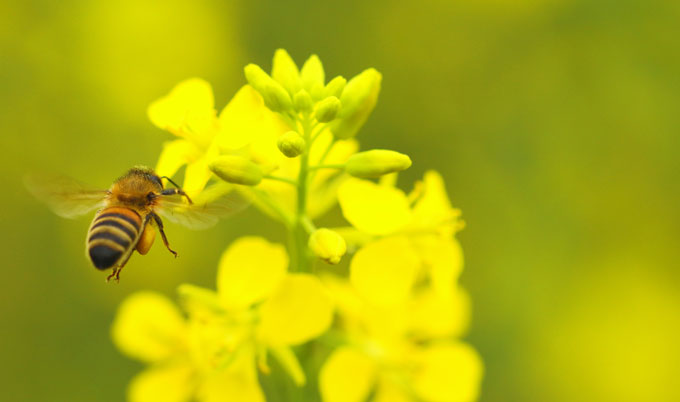Oilseed Rape
Breeding crops with pollinator-friendly traits
Published on: 14 March 2017
Plant breeding could be used to create crop varieties that benefit both bees for pollination and crop production.
Sugar content and the overall amount of nectar varies between commercial varieties of oilseed rape produced with different breeding systems, new research has revealed.
Experts at Newcastle University, Rothamsted Research and the University of Exeter have helped identify that plant breeding could be used to create crop varieties with pollinator-friendly traits, benefitting both bees for pollination and crop production.
In recent years, some beekeepers have suggested that hybrid varieties of oilseed rape may provide inferior nectar for pollinators compared with traditional open-pollinated varieties.

Selecting beneficial traits
Scientists at Newcastle University were part of a study which tested whether the amount and quality of nectar produced by glasshouse-grown oilseed rape plants varied between different crops.
More fundamentally, they focused on three conventional breeding systems used to create the varieties. Their study has been published in the journal, Global Change Biology Bioenergy.
The researchers demonstrated that while the amounts and sugar content of nectar were similar in varieties within the same breeding system, they differed between the breeding systems.
Geraldine Wright, professor of insect neuroethology at Newcastle University, said: “Bees are important for the pollination of crops and natural plant species.
“This work shows that it is possible to select for traits in crop plants like oilseed rape that are beneficial to bees.”
Supporting 250 bee species in the UK
Oilseed rape is an important component of many farmers’ arable crop rotations and the nectar and pollen produced by their yellow flowers provide a key source of nutrition for insect pollinators.
The UK has around 250 bee species, including the domesticated honey bee. Like many other insect pollinators, these bees need sources of nectar and pollen.
The declines in pollinator abundance in farmed landscapes is the result of several factors with the lack of available food resources thought to be a major contributor.
In this study varieties of oilseed rape produced with three different methods were tested by the experts. The scientists compared oilseed varieties representing open-pollinated (OP), genic male sterility (GMS) hybrid and cytoplasmic male sterility (CMS) hybrid breeding systems.
Analyses of the data demonstrated that while the amounts of nectar and sugar were similar in varieties within the same breeding system, they varied between the breeding systems, being significantly greater in GMS hybrids than in CMS hybrids and open-pollinated varieties.
Dr Jonathan Carruthers, previously a PhD student from Newcastle University working at Rothamsted Research, was part of the study.
“We measured a range of floral traits in varieties of winter oilseed rape grown in a glasshouse to test for variation within and between breeding systems," he said.
“Specifically, we quantified 24-hour nectar secretion rate, the amount, concentration and ratio of nectar sugars per flower, and the sizes and number of flowers produced per plant from 24 varieties.”
It is believed that plant breeding may be a useful tool to create crop varieties with enhanced pollinator-friendly traits.
Dr Alison Haughton, research scientist who led the study at Rothamsted Research, added:
“A lack of food resources in agricultural landscapes is a key challenge to our insect pollinators, and the pressure to provide for an expanding human population means such challenges will only intensify.
“We believe that it is important to explore novel ways of reducing the ecological impact of crops, and supporting biodiversity in arable landscapes, in the context of sustainable intensification.”
Reference:
Oilseed rape (Brassica napus) as a resource for farmland insect pollinators: quantifying floral traits in conventional varieties and breeding systems. Carruthers et al. (2017)
Global Change Biology Bioenergy, doi: 10.1111/gcbb.12438



